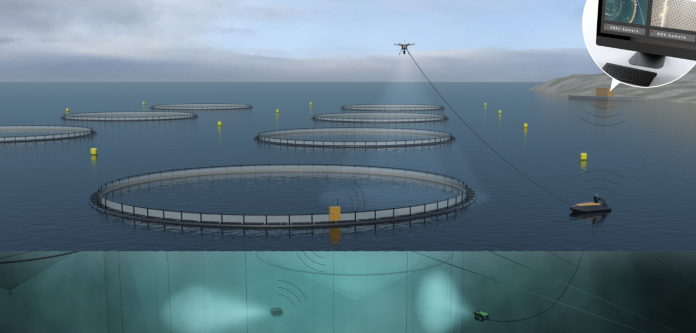Robotic technology is on its way into the aquaculture industry. It will enable management of farms from land.
Today, multi-manned service boats are used to carry out daily tasks at fish farms, such as monitoring of fish welfare, plant inspection and control of feeding, or counting of lice.
These operations are likely to be more demanding in the future because the industry plans to move much farther out into the ocean, where there are tougher weather and sea conditions. That’s why researchers are working on developing a ‘robot team’ that can do the job.
Full control – 24 hours a day
“There are many advantages with so-called autonomous and remote systems. These require fewer resources, control can take place around the clock and the safety of personnel will no longer be an issue,” says Per Rundtop, Aquaculture Research Scientist at SINTEF.
It’s good news for an industry that has challenging working conditions.
Researchers from SINTEF and NTNU, as well as developers from, among others, Maritime Robotics, Argus Remote Systems and Lerow are working together on robotics to take on the workload that humans are performing today.
“We have developed a lot of technology already, from driverless boats, drones and ROVs (Remotely Operated Vehicles), which can undertake inspection and maintenance of the plant underwater. The challenge is to make these technologies work efficiently,” says Eirik Evjen Hovstein, COO of Maritime Robotics.
Full-scale tests at Froya
Over the next year, technology will be tested at SINTEF ACE’s full-scale laboratory at Froya in Norway. The idea is that a driverless boat will carry the ROV and the drone to the facility.

“Outside the plant, the driverless boat will act as a landing platform and base station for a drone, while being able to navigate and function in collaboration with a ROV,” says Rundtop from SINTEF.
“It will be a bit like a ‘Surprise egg’. Three crafts in one, Eirik Evjen Hovstein adds.
Robots must work together
Research will be conducted in four different areas of the project, named ‘Artifex’: ship design, driverless systems, oxygen supply operations and underwater operations.
“For example, the drone can monitor feeding of fish while the ROV can carry out underwater inspection and work such as fixing weaknesses in the net before a hole becomes so large that escape is possible, and all these operations can be monitored and operated by a person on land. I think these are jobs many of today’s youth will find attractive. It’s almost like playing computer games, except that you’re actually doing a useful job,” Holstein says, smiling.
The innovation project is funded 50 percent of the Research Council of Norway, while the other half of the funding comes from business. The Artifex project started in 2016 and ends in 2018 with a budget of €1.9m.

